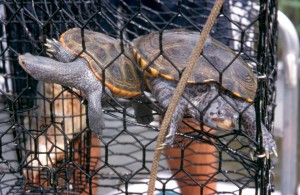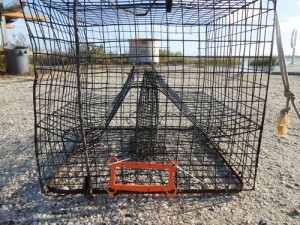 Part of the reason for this decline is the increasing use of commercial crab traps — for commercial and recreational purposes — in the same salt marsh creeks and sounds where terrapins dwell. This is a problem not only in New Jersey but also in other areas where terrapins occur (Bishop, 1993).
Part of the reason for this decline is the increasing use of commercial crab traps — for commercial and recreational purposes — in the same salt marsh creeks and sounds where terrapins dwell. This is a problem not only in New Jersey but also in other areas where terrapins occur (Bishop, 1993).
In New Jersey, a maximum of 27,565 commercial crab traps were reportedly in use in 2001. This number does not include unreported commercial crab traps or recreational traps also in use. Commercial crab trap use is even more intensive in other states. For example, some 650,000 crab traps are annually set along Louisiana’s coast (Arcement and Guillery, 1993).

After years of experimentation, researchers at the Wetlands Institute developed a simple, inexpensive and remarkably effective Bycatch Reduction Devices (BRDs) or “terrapin excluder” that can easily be fitted onto the inner (narrow) end of the entrance funnels of commercial crab traps. Several different designs (stiff wire rectangles with dimensions of 2 x 4 inches or 2 x 6 inches, and a diamond-shaped excluder with a maximum width of 6 inches and a maximum height of 2 inches) were tested by researchers at The Wetlands Institute; personnel from the New Jersey Division of Fish, Game and Wildlife; and even a few commercial crabbers. These tests have shown that:
- BRDs are highly effective at preventing terrapins from entering commercial crab traps.
- There is no decrease in the number or size of marketable crabs (more than 4¾ inches) caught in traps equipped with BRDs.
- There is actually an increase in the number of marketable-sized crabs caught when BRDs are used. This is because the BRDs reduce the dimensions of the inner funnel opening, making it more difficult for crabs to find their way out of the trap once they have entered it.
In view of all the foregoing facts, a new regulation has gone into effect in New Jersey as of January 1, 1998. This regulation states that all commercial-style traps used in waters less than 150 feet wide at low tied or in any man-made lagoon must be fitted with devices designed to exclude diamondback terrapins. These devices may be either rectangular or diamond shaped and no longer than 6 inches wide or 2 inches high. These devices should be attached across the opening at the narrow end of each funnel entrance. This regulation is intended to protect an increasingly threatened natural resource—diamondback terrapins—without detrimentally affecting the catch of New Jersey’s crabbers.
The reason that traps fitted with BRDs are only required to be used in certain situations is a reflection of the nonuniform distribution of terrapins in coastal waters. Terrapin populations are densest in salt marsh creeks and near marsh banks fringing the open waters of sounds and bays. Terrapins are less abundant in open waters, and are thus somewhat less likely to be caught in crab traps set in these areas.
Moreover, it is the intent of this regulation to require virtually everyone who uses commercial-type traps for recreational purposes (and the best available estimates are that there may be 10,000 or more traps annually used by recreational crabbers in New Jersey) to fit their traps with terrapins BRDs. (Note: The regulation discussed here pertains only to the use of commercial crab traps. Crab traps designed solely for recreational use, with sides that flip up when the trap cord is pulled, do not drown terrapins and are not governed by this regulation.
Literature Cited
- Arcement, E. and Guillory. 1993. Ghost fishing in vented and unvented blue crab traps. Proceedings of the Louisiana Academy of Science 56:1–7.
- Bishop, J. H. 1983. Incidental capture of diamondback terrapins by crab pots. Estuaries 6(4):426–430.
- Mann, T. M. 1995. Population surveys for diamondback terrapins (Malaclemys terrapin) and Gulf salt marsh snakes (Nerodia clarkii clarkii) in Mississippi. Mississippi Museum of Natural Science, Technical Report No. 37. 75 pp.
- Siegel, R. A. and J. W. Gibbons. 1995. Workshop in the ecology, status, and management of the diamondback terrapin (Malaclemys terrapin), Savannah River Ecology Laboratory, 2 August 1994: final results and recommendations. Chelonian Conservation and Biology 1(3):240–243.
- Wood, R. C. 1997. The impact of commercial crab traps on northern diamondback terrapins, Malaclemys terrapin terrapin. In J. Van Abbema (ed.), Proceedings: Conservation, Restoration, and Management of Tortoises and Turtles—An International Conference, pp. 21–27. A joint publication of the New York Turtle and Tortoise Society and The Wildlife Conservation Society Turtle Recovery Program. 494 pp.
